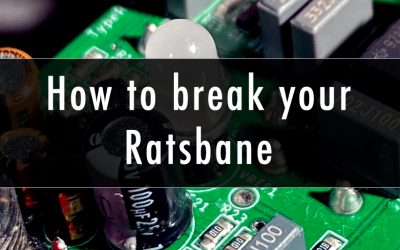
A Chorus Pedal – how does it work?? Waaaaay back when we were first talking about the Terraform, I started to dig around various articles about how each of the modulation effect works and what the distinctions were between them, as always, there were an absolute shedful of articles written that all basically said the same thing, the signal is split into two, one is detuned and delayed a little and stuffed back on top of the other, but that was about it.
So, for fun, and because it’s cool to actually see how it works, I’m going to try to replicate some of the classic modulation sounds in LogicX, and build each one from the ground up and showing what is actually happening at the same time. Now, if you are going to skip straight to the example at the bottom expecting to hear the Terraform chorus, or a CE-1, or whatever, than you are going to be disappointed, as I’m not trying to replicate a classic tone, or even make an outstanding one, I just want to demonstrate how it works – in order to do this, I’ve had to push the parameters a little to highlight each composite part to make them more noticeable.
Before we get into the good stuff, let’s take a moment to remember what the humble chorus pedal was trying to do when it was first conceived. It is designed to replicate the effects that is heard when a group of singers are all singing the same line. Because of the nature of humanity and before the advent of digital manipulation, very few of them will be perfectly in time or even singing the exact same note, so there is a oscillation that occurs and the chorus effect was born. The chorus pedal was designed to replicate that happening. It’s replicating a vocal chorus ensemble.
The first thing a chorus pedal does is split the signal. It takes the original signal, replicates it, effects the duplication and then puts them back together. In the interest of consistency, I recorded one guitar line, one time through – direct into the sound card, and copied and pasted it so you know the only things that have changed are those that are shown on the screen.
You will notice that the video has 5 distinct parts to it, here is a breakdown of what each part is.
Please listen through headphones as some of the differences are quite subtle.
Part 1: Track 1.
The dry track. The line was recorded once, then copied, pasted and joined. It’s literally the same line repeated over and over (and yes, it will drive you kinda nuts after a while but it had to be consistent). This line is always on, the ‘dry’ line is always present, it has to be for the effect to work.
Part 2: Track 2.
Track 2 is identical to track 1 except it has been detuned -20 cents. Once they are played together, the familiar wetness and swirl of the chorus starts to present itself.
Part 3: Track 3.
With the detuning still in place, I have now delayed that line by 22ms, set to 100% wet. Now, this is quite a long delay for a chorus, but this way you get to feel the doubling effect.
Part 4: Track 4 and 5.
I split the ‘wet’ track into two, and the inverted the phase of one of them – now, this isn’t a classic chorus style, but you can hear the width really start to stand out.
Part 5: Tracks 6 and 7.
It was all starting to feel a little HiFi (but, you know, I quite liked it) so I put a HPF (High Pass Filter) and a LPF (Low Pass Filter) on it, just to hear what it would sound like.
Most of those provide us the composite parts of what makes a Chorus pedal sound like the effect we are familiar with Obviously, the thing that is missing from the above demonstration is the overall movement, the swirl, we’ve all come to love (especially those of us who learned to play in the 80’s). In order to achieve the swirl, the detune element is moved above and below the main line in what we call an LFO (low frequency oscillation – the wave form that’s moving the detune). You can see below the LFO on the replicated line. The detune is moving between +10 and -10 (keep an eye on the ‘cents’ in the Soundhack plug_in). The delay is set to 10ms which is pretty standard for a chorus.
The wave passes 3 times throughout the line, this represents a slow rate and shallow depth (the rate is the speed the detuning goes between + and – ) and the depth is how deep the detune happens. The you can see the rate is slow, and the detune is going to about + and – 10 cents). The second run through is a slow rate and a much deeper sweep of the detune, this time to about + and – 20 cents, so that’s the depth control turned up. The third pass is a much faster rate, double the previous at 6, and deeper still to about + and – 25 cents) and we are starting to get into seasick territory!
On to stereo… I’ve replicate the above, same breakdown but this time there are two lines running as well as the original, panned hard left and right, and the second one is running a little behind the other – when you have headphones in this will give you the effect of running a chorus in stereo!
The Eagle-eyed among you will notice I’ve dropped the depth a little on the high rate/deep depth in the stereo example, from 25 to 20. It was making me nauseous!
So, how does my homemade (in LogicX) sound in the real world? It’s not too bad really, but it certainly lacks the finesse of one you could buy. I found the multitrack stems of Under Pressure by Queen, that allowed me to (mostly) remove Brian’s guitar. Taking into consideration how Brian plays it live and kinda replicating it, I put my chorus into the song for a minute and a half… you can see the chorus working (in stereo) with the base tone coming from the Amplitude Brian May pack, which is soooooo good it’s ridiculous!



Love your videos; love your pedals too.
I’m wondering what would happen if you had the delay on a different, non-identical, lfo going Friday say 5-15 ms of delay. Would that increase the swirl, or just be a mess?
It wouldn’t sound particularly nice!!
You’ve opened my ears up,i had no idea what you did, you’re going to change the way I’m going to sound in the future ! Thanks, tom
This is fascinating. I’ve always kind of understood it but this really makes it clear. I look forward to other modulation effects.
Hey Shane, so glad you enjoyed it! Expect a flanger one next week!
Excellent explanation and done in a way that makes it easy to see the components of the chorus effect.
I had a physics prof in college who also played guitar in a local band. He found out that I played too and one afternoon during his office hours, I stopped by. After answering a question for me, he wrote out a series of equations on his office whiteboard that mathematically expressed the chorus effect.
Your demonstration essentially illustrates the same components as my former physics professor’s equation set.
Well done.
Thanks Kirk! I’m taking that to mean I’m now a full Physics Professor!!
amazing explanation! I would really like to know wich component produces this time detuning, I’m having a hard time trying to understand it by my self. thanks!
Hello all! Not sure if I’m too late here but my question is why do choruses phase invert the modulated signal? If I’m running to Amps in phase then engage the stereo chorus I lose much of my low end frequencies. I’ve tried an ABY box with a phase inverter switch and that works great putting that signal back in phase. So why invert to begin with? Thank you!!!